The government of the UKUK The Government,

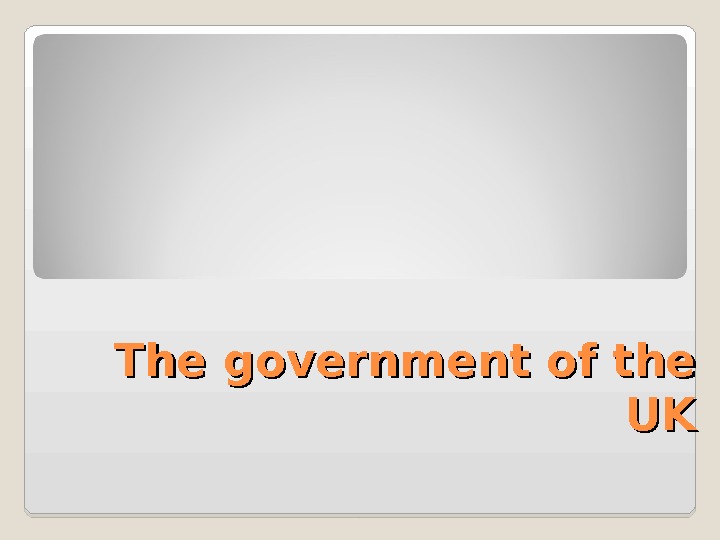
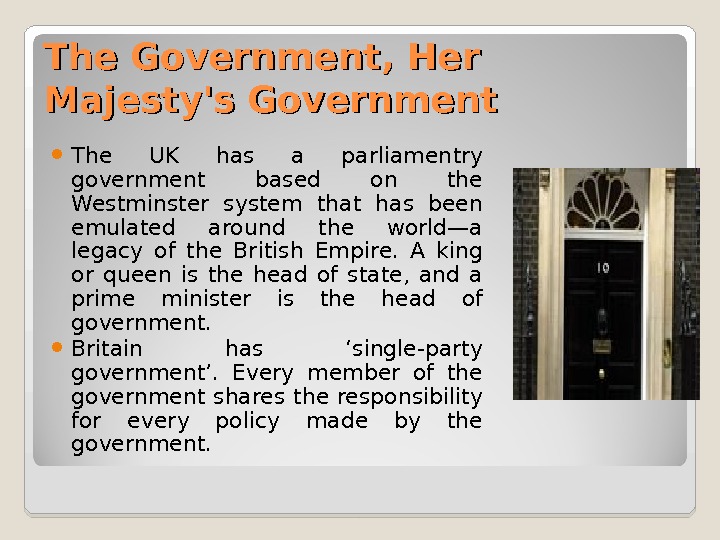



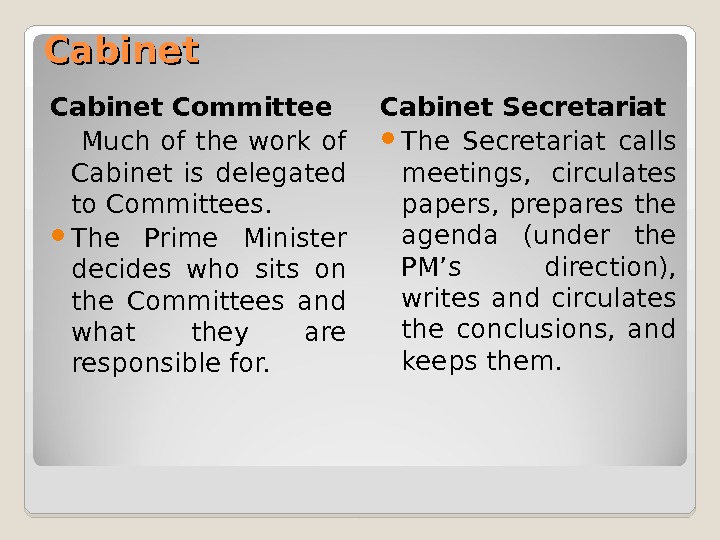
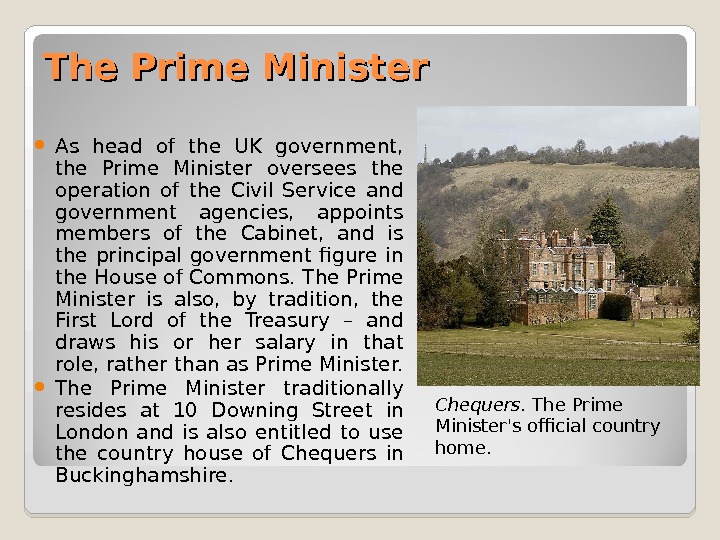


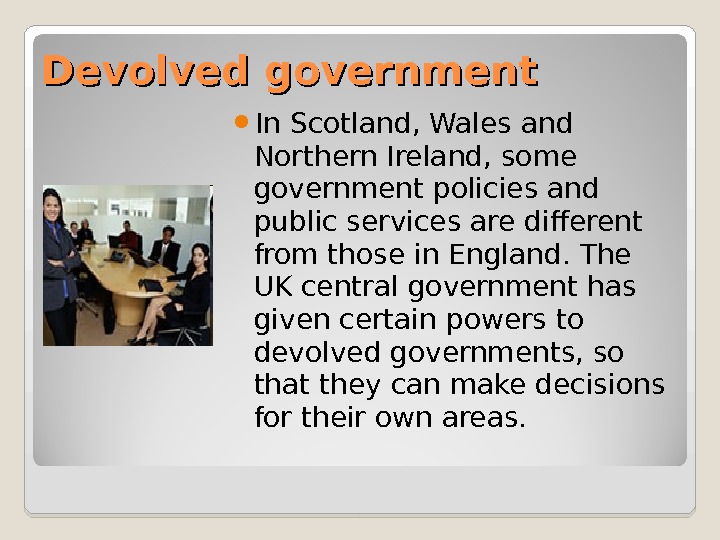
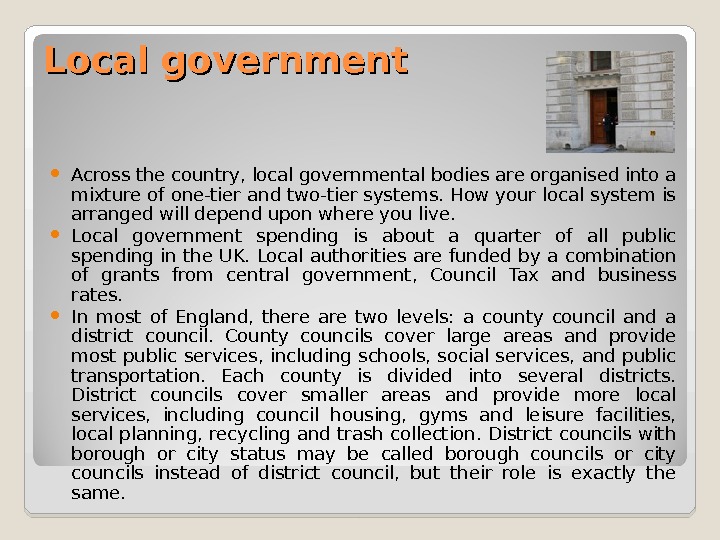
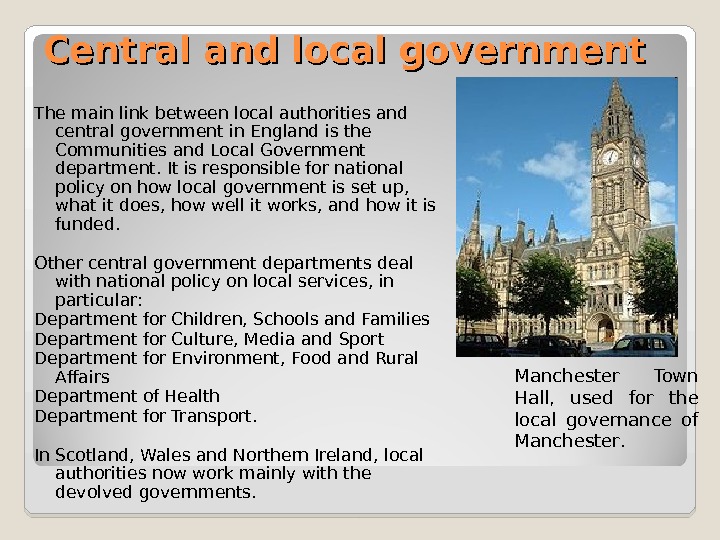
- Размер: 2 Mегабайта
- Количество слайдов: 12
Описание презентации The government of the UKUK The Government, по слайдам
 The government of the UKUK
The government of the UKUK
 The Government, Her Majesty’s Government The UK has a parliamentry government based on the Westminster system that has been emulated around the world—a legacy of the British Empire. A king or queen is the head of state, and a prime minister is the head of government. Britain has ‘single-party government’. Every member of the government shares the responsibility for every policy made by the government.
The Government, Her Majesty’s Government The UK has a parliamentry government based on the Westminster system that has been emulated around the world—a legacy of the British Empire. A king or queen is the head of state, and a prime minister is the head of government. Britain has ‘single-party government’. Every member of the government shares the responsibility for every policy made by the government.
 Government ministers Most ministers are members of the House of Commons, although the government is also fully represented by ministers in the House of Lords. The composition of governments can vary both in the number of ministers and in the titles of some offices. New ministerial offices may be created, others may be abolished, and functions may be transferred from one minister to another. Tony Blair and Dick Cheney at the main door to 10 Downing Street, the Prime Minister’s residence in London, on 11 March, 2002.
Government ministers Most ministers are members of the House of Commons, although the government is also fully represented by ministers in the House of Lords. The composition of governments can vary both in the number of ministers and in the titles of some offices. New ministerial offices may be created, others may be abolished, and functions may be transferred from one minister to another. Tony Blair and Dick Cheney at the main door to 10 Downing Street, the Prime Minister’s residence in London, on 11 March, 2002.
 Her Majesty’s Government The Prime Minister and Cabinet are formally appointed by the Monarch to form Her Majesty’s Government , though the Prime Minister chooses the Cabinet, and by convention HM The Queen respects the Prime Minister’s choices. David Cameron
Her Majesty’s Government The Prime Minister and Cabinet are formally appointed by the Monarch to form Her Majesty’s Government , though the Prime Minister chooses the Cabinet, and by convention HM The Queen respects the Prime Minister’s choices. David Cameron
 The Cabinet is the committee at the centre of the British political system and the supreme decision-making body in government. The cabinet meets once a week, e very Tuesday , in the Cabinet room in Downing Street and takes decisions about new policies, the implementation of existing policies and the running of the various government departments. Meetings are currently attended by 22 paid ministers and one unpaid minister appointed to Cabinet, and six other invited ministers and peers. Government Cabinets have met in the same room since 1856, when it was called the Council Chamber.
The Cabinet is the committee at the centre of the British political system and the supreme decision-making body in government. The cabinet meets once a week, e very Tuesday , in the Cabinet room in Downing Street and takes decisions about new policies, the implementation of existing policies and the running of the various government departments. Meetings are currently attended by 22 paid ministers and one unpaid minister appointed to Cabinet, and six other invited ministers and peers. Government Cabinets have met in the same room since 1856, when it was called the Council Chamber.
 Cabinet Committee Much of the work of Cabinet is delegated to Committees. The Prime Minister decides who sits on the Committees and what they are responsible for. Cabinet Secretariat The Secretariat calls meetings, circulates papers, prepares the agenda (under the PM’s direction), writes and circulates the conclusions, and keeps them.
Cabinet Committee Much of the work of Cabinet is delegated to Committees. The Prime Minister decides who sits on the Committees and what they are responsible for. Cabinet Secretariat The Secretariat calls meetings, circulates papers, prepares the agenda (under the PM’s direction), writes and circulates the conclusions, and keeps them.
 The Prime Minister As head of the UK government, the Prime Minister oversees the operation of the Civil Service and government agencies, appoints members of the Cabinet, and is the principal government figure in the House of Commons. The Prime Minister is also, by tradition, the First Lord of the Treasury – and draws his or her salary in that role, rather than as Prime Minister. The Prime Minister traditionally resides at 10 Downing Street in London and is also entitled to use the country house of Chequers in Buckinghamshire. Chequers. The Prime Minister’s official country home.
The Prime Minister As head of the UK government, the Prime Minister oversees the operation of the Civil Service and government agencies, appoints members of the Cabinet, and is the principal government figure in the House of Commons. The Prime Minister is also, by tradition, the First Lord of the Treasury – and draws his or her salary in that role, rather than as Prime Minister. The Prime Minister traditionally resides at 10 Downing Street in London and is also entitled to use the country house of Chequers in Buckinghamshire. Chequers. The Prime Minister’s official country home.
 The Prime Minister’s Responsibilities The Prime Minister presides over the Cabinet, is responsible for allocating functions among ministers and, at regular meetings with the Queen, informs her of the general business of the government. The Prime Minister’s other responsibilities include recommending a number of appointments to the Queen. These include high-ranking members of the Church of England, senior judges and certain civil appointments. He also recommends appointments to several public boards and institutions, as well as to various royal and statutory commissions. The Prime Minister’s Office supports him in his role as head of government. This includes providing policy advice, tracking the delivery of government commitments and initiatives, and ensuring effective communications to Parliament, the media and the public.
The Prime Minister’s Responsibilities The Prime Minister presides over the Cabinet, is responsible for allocating functions among ministers and, at regular meetings with the Queen, informs her of the general business of the government. The Prime Minister’s other responsibilities include recommending a number of appointments to the Queen. These include high-ranking members of the Church of England, senior judges and certain civil appointments. He also recommends appointments to several public boards and institutions, as well as to various royal and statutory commissions. The Prime Minister’s Office supports him in his role as head of government. This includes providing policy advice, tracking the delivery of government commitments and initiatives, and ensuring effective communications to Parliament, the media and the public.
 The Civil Service carries out the practical and administrative work of government. Civil servants are politically impartial employees, who carry out the policies of the government departments under the control of elected ministers. About half of all civil servants provide services direct to the public. These include paying benefits and pensions, running employment services, staffing prisons, issuing driving licences, and providing services to industry and agriculture. About 80 per cent of civil servants work outside London. It is sometimes said that it is they and not their ministers, who really govern the country.
The Civil Service carries out the practical and administrative work of government. Civil servants are politically impartial employees, who carry out the policies of the government departments under the control of elected ministers. About half of all civil servants provide services direct to the public. These include paying benefits and pensions, running employment services, staffing prisons, issuing driving licences, and providing services to industry and agriculture. About 80 per cent of civil servants work outside London. It is sometimes said that it is they and not their ministers, who really govern the country.
 Devolved government In Scotland, Wales and Northern Ireland, some government policies and public services are different from those in England. The UK central government has given certain powers to devolved governments, so that they can make decisions for their own areas.
Devolved government In Scotland, Wales and Northern Ireland, some government policies and public services are different from those in England. The UK central government has given certain powers to devolved governments, so that they can make decisions for their own areas.
 LL ocal government Across the country, local governmental bodies are organised into a mixture of one-tier and two-tier systems. How your local system is arranged will depend upon where you live. Local government spending is about a quarter of all public spending in the UK. Local authorities are funded by a combination of grants from central government, Council Tax and business rates. In most of England, there are two levels: a county council and a district council. County councils cover large areas and provide most public services, including schools, social services, and public transportation. Each county is divided into several districts. District councils cover smaller areas and provide more local services, including council housing, gyms and leisure facilities, local planning, recycling and trash collection. District councils with borough or city status may be called borough councils or city councils instead of district council, but their role is exactly the same.
LL ocal government Across the country, local governmental bodies are organised into a mixture of one-tier and two-tier systems. How your local system is arranged will depend upon where you live. Local government spending is about a quarter of all public spending in the UK. Local authorities are funded by a combination of grants from central government, Council Tax and business rates. In most of England, there are two levels: a county council and a district council. County councils cover large areas and provide most public services, including schools, social services, and public transportation. Each county is divided into several districts. District councils cover smaller areas and provide more local services, including council housing, gyms and leisure facilities, local planning, recycling and trash collection. District councils with borough or city status may be called borough councils or city councils instead of district council, but their role is exactly the same.
 Central and local government The main link between local authorities and central government in England is the Communities and Local Government department. It is responsible for national policy on how local government is set up, what it does, how well it works, and how it is funded. Other central government departments deal with national policy on local services, in particular: Department for Children, Schools and Families Department for Culture, Media and Sport Department for Environment, Food and Rural Affairs Department of Health Department for Transport. In Scotland, Wales and Northern Ireland, local authorities now work mainly with the devolved governments. Manchester Town Hall , used for the local governance of Manchester.
Central and local government The main link between local authorities and central government in England is the Communities and Local Government department. It is responsible for national policy on how local government is set up, what it does, how well it works, and how it is funded. Other central government departments deal with national policy on local services, in particular: Department for Children, Schools and Families Department for Culture, Media and Sport Department for Environment, Food and Rural Affairs Department of Health Department for Transport. In Scotland, Wales and Northern Ireland, local authorities now work mainly with the devolved governments. Manchester Town Hall , used for the local governance of Manchester.

